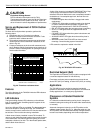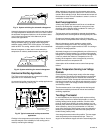
T874 MULTISTAGE THERMOSTATS AND Q674 SUBBASES
60-2485—824
one controllin
g
the auxiliar
y
heat
)
makes onl
y
when the heat
pump alone cannot handle the load. That is how the strate
gy
of usin
g
the most economical heat first is implemented.
Cycling Rate
Normall
y
, thermostat anticipation is set to c
y
cle a fossil fuel
furnace about five or six times an hour
(
at 50 percent load
)
.
This provides a reasonable balance between comfort, stabilit
y
and econom
y
.
A heat pump, bein
g
a mechanical refri
g
eration s
y
stem, should
be c
y
cled at a rate of 2-1/2 to 3 times an hour. With a T874,
this is accomplished b
y
settin
g
the anticipator at the total
current draw of the controlled device
(
the contactor and
possibl
y
the chan
g
eover rela
y
or valve
)
. Most likel
y
, the
compressor operates from the first sta
g
e of the thermostat.
The second sta
g
e normall
y
controls the auxiliar
y
heaters. This
heat anticipator can be set for the current draw of the electric
heat primar
y
, and produces
g
ood control.
Voltage Anticipation
Althou
g
h not a specific re
q
uirement for heat pumps, several
models of the T874 have volta
g
e heat anticipation instead of
current anticipation.
With volta
g
e anticipation, the amount of heat added to the
thermostat is constant no matter which load is connected to it.
The anticipator realizes a constant volta
g
e and produces a
constant amount of heat durin
g
the ON c
y
cle. This allows the
c
y
clin
g
rate to be
designed into
the thermostat. The heat
pump manufacturer is assured of correct performance
independent of later thermostat ad
j
ustments.
Outdoor Reset
Outdoor reset, which a C815A Outdoor Thermistor makes
possible, is sometimes applied in heat pump s
y
stems to help
minimize the effect of the differential between sta
g
es. It takes
2°F
(
1.1°C
)
chan
g
e in temperature to brin
g
on the second
sta
g
e and full heatin
g
. Added to a certain amount of droop
under hi
g
h loads, there can be a lar
g
e offset between the
setpoint and room temperature.
Without some method to counteract this situation, the
temperature offset from the setpoint could be as much as 6°F
(
3.3°C
)
under hi
g
h load conditions. It is not likel
y
that the
occupants accept this variation without makin
g
fre
q
uent
thermostat settin
g
chan
g
es.
Outdoor reset has the effect of raisin
g
the setpoint at cold
outdoor temperatures. Then, even with a few de
g
rees droop,
the space temperature sta
y
s near the desired settin
g
.
This is done b
y
calibratin
g
the thermostat hi
g
h b
y
5°F
(
3°C
)
—
the amount of expected offset. This offset compensates for
differential and droop at hi
g
h load factors so the thermostat
switches at the setpoint. At warm temperatures, heat is added
to the thermostat to compensate for this offset; at cold
temperatures, the extra heat is automaticall
y
removed. The
effect is the same as raisin
g
the setpoint as the outdoor
temperature
g
oes down.
This is particularl
y
important on the 3-sta
g
e T874. The
additional sta
g
e means that more droop is introduced when
the s
y
stem is in operation. That is the reason the TRADELINE
T874W is sold in a packa
g
e with the outdoor sensor and the
correct subbase.
Outdoor Reset—How it Works
The heater in the thermostat is connected in series with a
thermistor sensor that measures outdoor temperature. See
Fi
g
. 34. In warm weather, the thermistor has ver
y
low
resistance, permittin
g
a lar
g
e current flow in the heater, which
g
enerates a relativel
y
lar
g
e amount of heat in the thermostat.
In cold weather, the outdoor sensor has hi
g
h resistance,
which results in low current flow and little or no heat bein
g
added to the thermostat. This raises the control point,
overcomin
g
the effects of droop and intersta
g
e differential.
Fig. 34. Location of thermistor.
Changeover
Chan
g
eover between heatin
g
and cooin
g
can be
accomplished either
automatically
or
manually
, dependin
g
on
the application. Chan
g
eover can occur in heatin
g
or coolin
g
.
The chan
g
eover valve is ener
g
ized as lon
g
as the subbase
function switch is in the appropriate position when
manual
chan
g
eover is used. If a s
y
stem manuall
y
chan
g
es over on
coolin
g
, the valve ener
g
izes whenever the subbase switch is
in the coolin
g
mode.
One of the mercur
y
bulb switches is used for control when the
thermostat has
automatic
chan
g
eover. When the
automatic
chan
g
eover is in coolin
g
, the chan
g
eover valve is ener
g
ized
when the first sta
g
e coolin
g
switch makes. The second sta
g
e
switch turns on the compressor.
It is more common with new e
q
uipment to find that
chan
g
eover occurs with coolin
g
; that is, the chan
g
eover valve
is ener
g
ized to produce coolin
g
.
Whether
automatic
or
manual
chan
g
eover is used and
whether the reversin
g
valve is ener
g
ized with coolin
g
or with
heatin
g
, a heat pump s
y
stem can be controlled b
y
the
appropriate T874 Multista
g
e Thermostat.
L1
(HOT)
L2
RESET
HEATER
C815A
OUTDOOR
THERMISTOR
SENSOR
M5826


















